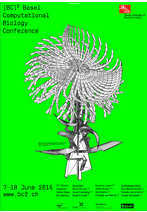T5: ChIP-Seq data analysis via the web: an introduction to the Nebula, ChIP-seq and Signal Search Analysis servers.
Organizers:
Philipp Bucher (EPFL, Lausanne), and Valentina Boeva (Institut Curie, Paris, France)
Tutorial Summary:
Chromatin immunoprecipitation followed by high-throughput sequencing (ChIP-seq) is the technique of choice for identification of DNA binding sites of transcription factors and other DNA-associated proteins such as histone modification sites and histone variants. A ChIP-seq data analysis includes standard initial analysis steps (i.e. read mapping and peak calling) and a number of customizable peak postprocessing steps. The latter can comprise different quality controls, assignment of peaks to genes, DNA motif discovery, correlating peak locations with gene expression values and genomic context analysis via aggregations plots (APs). The application of all these analysis steps using a combination of several command line tools is a complicated task, even for experienced bioinformaticians. However, current web-based pipelines can significantly simplify this task and make this type of data analysis accessible for biologists.
We would like to present to the general audience of biologists and bioinformaticians the main steps of ChIP-seq data analysis together with web-based tools that can be extremely useful for this task. In the workshop we will cover the main functionalities of the Nebula web-service allowing for the complete ChIP-seq data analysis (from read mapping to the basic analysis of peak features) and introduce participants to the complementary tools available from the ChIP-seq and Signal Search Analysis (SSA) web servers of the Swiss Institute of Bioinformatics.
Expected goals:
By attending the proposed tutorial, we expect the participants:
- To acquire a basic understanding of ChIP-seq data, analysis methods, and DNA sequence motifs
- To get acquainted with the on-line tools presented during the tutorial and to be able to use these tools efficiently after the tutorial.
Level: intermediate, depending on background. Participants should have good knowledge in either experimental or computational genomics, or basic knowledge in both areas.
Intended audience. Bioinformaticians actively involved in ChIP-seq data analysis, biologists interested in ChIP-seq data analysis methods and tools, bioinformaticians with a computational background interested in learning more about the biological aspects of ChIP-seq data analysis.
Prerequisites: Laptop with internet access; Adobe Reader installed to have access to the electronic materials of the tutorial (slides and working manuals).
Tutorial speakers:
Valentina Boeva is a research scientist from the Institut Curie who works on data integration and the development of high throughput sequencing data analysis methods to study regulation in cancer. She and her group designed and implemented bioinformatics tools in two main areas: (i) Analysis of copy number alterations and structural variants in cancer genomes: FREEC/Control-FREEC, SVDetect, SV-Bay, ONCOCNV; and (ii) Analysis of ChIP-seq data: MICSA, HMCan and Nebula.
Philipp Bucher is a group leader in bioinformatics at EPFL. His research focuses on transcriptional regulation and computational methods to analysis gene regulatory regions. He has created the Eukaryotic Promoter Database EPD almost 30 years ago and subsequently developed several sequence analysis software tools including Signal Search Analysis, ESTScan and the PFTOOLS package.
Giovanna Ambrosini is a senior research assistant in Philipp Bucher's group. Together, they developed the ChIP-Seq and PWMTools programs and web servers. She also designed the web interface for the Signal Search Analysis tools and is responsible for the large public data collection behind these servers.
Tutorial Agenda
Tuesday, June 9, 2015
| 14:00 – 14:30 | Introduction to the first step of ChIP-seq data processing: quality controls, read alignment; presentation of Nebula (http://nebula.curie.fr/) |
| 14:30 – 15:00 | Peak calling for transcription factor and histone modification data |
| 15:00 – 15:30 | Annotation of genes and ChIP-seq peaks and de novo motif calling in Nebula |
| 15:30 – 16:00 | Coffee break |
| 16:00 - 16:30 |
Introduction to the ChIP-seq (http://ccg.vital-it.ch/chipseq/), SSA (http://ccg.vital-it.ch/ssa/) and PWMTools (http://ccg.vital-it.ch/pwmtools) |
| 16:30 - 17:00 | Quality control, peak finding, and genomic context analysis with the ChIP-Seq server; interoperability with other tools including NebulaQuality control, peak finding, and genomic context analysis with the ChIP-Seq server; interoperability with other tools including Nebula |
| 17:00 - 17:45 | Exploring public data with the ChIP-seq and SSA server tools; motif-driven approaches for ChIP-seq data analysis |






